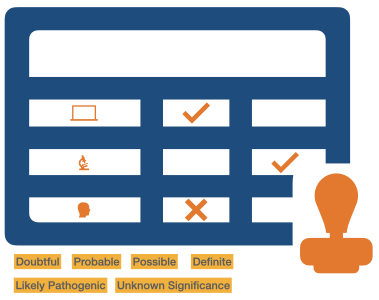Role of rubrics in the Determination of Association, Causation, and Classification in the Medical Field

Introduction
With advances in technology and human understanding of physiological processes, the number of associations between medically relevant entities, like disease, genes, genomic variations, environmental factors, drugs, side-effects, safety, and efficacy of interventions is reported routinely in peer-reviewed articles. However, evidence that supports these claims varies widely and is gauged differently by medical professionals. More than ever, there is a need for clear guidelines and rubrics to combine, weigh, and measure the strength of association, causation, and classification of medically relevant entities. This article summarizes some of the well-accepted and widely-used rubrics and their importance in the transparent communication of associations. These rubrics provided are at the epicenter of next-generation evidence-based medicine and provide a solid foundation for transparent communication of evidence and strength of associations.
Some of the rubrics that provided guidelines and quantitative/semi-quantitative measures to define associations are:
- Naranjo Scale
- Drug Interaction Probability Scale (DIPS)
- ClinGen Clinical Validity Framework
- ACMG/AMP Variant Classification
- Potential drug-drug interaction minimal information model (PDDI-MIM)
- Common Terminology Criteria for Adverse Events (CTCAE)
- NEQAS Variant Classification
- The Fryback–Thornbury Hierarchic Model of Efficacy
- Genetic testing Evidence Tracking Tool (GETT)
Next, we describe some of the rubrics mentioned above and briefly introduce and summarize their primary objectives.
Drug Interaction Probability Scale (DIPS)
DIPS is a semi-quantitative measure to identify and estimate the strength of drug-drug interactions. The rubric constitutes ten questions that help distinguish the symptoms arising from drug-drug interactions from ones arising from the primary disease. Answers to the questions in the DIPS rubric also provide categorical probability measures (doubtful, possible, probable, and highly probable) of drug-drug interactions.
Naranjo Scale
Naranjo Scale is a rubric that helps to determine the association between a drug and adverse reaction. Published adverse reaction case reports in patients almost always accompany Naranjo Score. It constitutes ten questions, and answering them helps determine the strength of association between a drug and side-effects observed in a given patient. The use of this rubric helps to categorize adverse reactions caused by a drug in four semi-quantitative categories: doubtful, possible, probable, and definite. Naranjo Score is often used in monitoring post-market drug surveillance.
ClinGen Clinical Validity Framework
Advances and access to sequencing technology consequently increased the number of gene-disease associations described in the literature. Similarly, experiments in animal models and large-scale functional data screening further increased the evidence base supporting gene-disease relations. The gene-validity rubric published and updated by the Clinical Genome Resource project provided a systematic way to combine evidence from various sources, weigh and estimate the strength of gene-disease association. Use of rubric semi-quantitatively classifies gene-disease association in 7 categories: Conflicting, No Evidence, Limited, Moderate, Moderate, Strong, or Definite. The gene-validity framework developed by ClinGen is a community accepted rubric, and different organizations use it to determine and report the validity of gene-disease association.
ACMG/AMP Variant Classification
Does a genetic variant identified in a patient is responsible for causing a specific phenotype? is one of the most common questions encountered by genetic testing laboratories. Guideline and rubric developed and published by ACMG/AMP help answer this question in a structured, semi-quantitive manner. Going beyond other rubrics, ACMG/AMP provides a tag to identify and determine pathogenicity's strength and direction for each type of evidence. It also provides flexibility to upgrade or downgrade the power of the evidence depending upon the gene or disease under consideration. The ACMG/AMP rubric classifies the variant semi-quantitatively as a pathogenic, likely pathogenic, variant of unknown significance, likely benign or benign.
Efforts to develop such rubrics are inevitable for the next generation practice of evidence-based medicine. It helps determine the strength of association based on quantitative and community accepted standards, increasing the usability. It also paves the foundation for artificial intelligence to use this matrix and determine the strength of associations with minimum input by human counterparts.
References:
- Hochheiser, H., Jing, X., Garcia, E., Ayvaz, S., Sahay, R., Dumontier, M., ... & Boyce, R. D. (2020). A minimal information model for potential drug-drug interactions. Frontiers in Pharmacology, 11, 2477.
- Horn, J. R., & Hansten, P. D. (2007). DIPS: A Tool to Evaluate Causation in Potential Drug Interactions. Pharmacy Times, 73(10), 84.
- Horn, J. R., Hansten, P. D., & Chan, L. N. (2007). Proposal for a new tool to evaluate drug interaction cases. Annals of Pharmacotherapy, 41(4), 674-680.
- Houge, G., Laner, A., Cirak, S., de Leeuw, N., Scheffer, H., & den Dunnen, J. T. (2021). Stepwise ABC system for classification of any type of genetic variant. European Journal of Human Genetics, 1-10.
- https://clinicalgenome.org/
- Richards, S., Aziz, N., Bale, S., Bick, D., Das, S., Gastier-Foster, J., ... & Rehm, H. L. (2015). Standards and guidelines for the interpretation of sequence variants: a joint consensus recommendation of the American College of Medical Genetics and Genomics and the Association for Molecular Pathology. Genetics in medicine, 17(5), 405-423.
- Rousseau, F., Lindsay, C., Charland, M., Labelle, Y., Bergeron, J., Blancquaert, I., ... & IFCC Scientific Division Committee on Molecular Diagnostics. (2010). Development and description of GETT: a genetic testing evidence tracking tool. Clinical chemistry and laboratory medicine, 48(10), 1397-1407.
- Savarese, D. M. (2013). Common terminology criteria for adverse events. UpToDate Waltham, MA: UpToDate.
- Shtar, G., Rokach, L., & Shapira, B. (2019). Detecting drug-drug interactions using artificial neural networks and classic graph similarity measures. PloS one, 14(8), e0219796.
- Strande, N. T., Riggs, E. R., Buchanan, A. H., Ceyhan-Birsoy, O., DiStefano, M., Dwight, S. S., ... & Berg, J. S. (2017). Evaluating the clinical validity of gene-disease associations: an evidence-based framework developed by the clinical genome resource. The American Journal of Human Genetics, 100(6), 895-906.